What you really need to know about evergreen hedges for privacy
There are many good reasons for choosing hedges for privacy.
Evergreen hedges provide food and shelter for wildlife all year round. Like trees, they’re good for the environment generally, because they improve air quality.
And if you want privacy, there are often different regulations covering fences and hedges. Hedges can often be higher, especially if you live in the UK. Hedges are an excellent choice for garden screening.
If you’re evaluating all your options for garden privacy, not just hedging, then see my book The Complete Guide to Garden Privacy, available on Kindle or paperback in up to 13 countries.

The best evergreen hedges for privacy
Here are the best evergreen hedges for privacy. Read on for the pros and cons of each one.
- Privet
- Portuguese Laurel
- Griselinia
- Viburnum tinus
- Bamboo (check variety carefully)
- Hornbeam (not evergreen but it holds its leaves in winter)
- Ivy
How to avoid mistakes when choosing a hedge for privacy
I asked Daniel Bentham of Best4Hedging hedge specialists about the mistakes people make when choosing hedges for privacy.
‘People forget to check the rate of growth of a hedge before they buy,’ he said. ‘So they choose something very slow-growing like yew when they want privacy fast. Or they choose something fast-growing like a Leylandii when they only want to clip once a year.’
The next biggest mistake, he says, is to forget that a new hedge needs extra nutrition while it’s establishing itself.
‘While the majority of people understand that a new hedge needs regular watering, many don’t realise that they’ll benefit enormously from being fed. We recommend a mix of three feeds: Rootgrow , bonemeal and Afterplant.’ Rootgrow has beneficial mycrorrhizal fungus to help roots get established, bonemeal feeds the young hedge and Afterplant is a top dressing with responsibly sourced seaweed.’
Note: links to Amazon are affiliate links. If you buy, I may get a small fee. See disclosure.
See this video on how to plant a hedge:
1) Privet – one of the best hedges for privacy
Privet (ligustrum) has a somewhat suburban reputation, but it’s also being used more in a design context now. It’s certainly one of the best hedges for privacy as it’s evergreen and grows fast, but never gets too high.
Garden consultant Posy Gentles considers it a top hedging choice because it clips into neat shapes like box. It doesn’t have the problems that box currently has (with box blight and box tree moth) and it grows faster. It’s a good choice if you want a hedge up to 8ft (around 2.5m).
However, Daniel Bentham warns that privet can suffer in harsh winters. It also needs clipping at least twice a year – I sometimes clip mine three times a year.
2) Portuguese Laurel
Daniel’s top recommendation for a hedge for privacy is Portuguese Laurel, which has glossy dark green leaves and red stems.
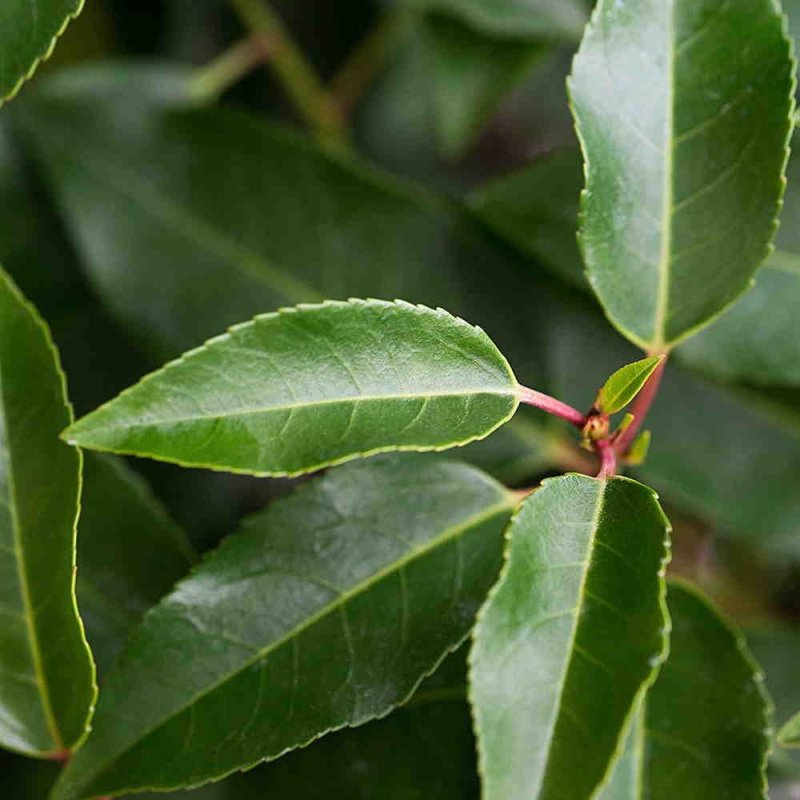
Portuguese laurel from Best4Hedging
We had a Portuguese Laurel hedge all round my childhood home in Surrey. My mother simply planted sticks of it straight into the ground, and it turned into a hedge within a couple of years. It withstood droughts, bad winters and torrential rain.

The trunk of a Portuguese Laurel at Great Dixter with euphorbia around the base. Like my parents’ hedging, it has got a little out of control.
However, it grew quickly and did get really big. My father had a strange aversion to pruning, so we eventually had a forest around us. You could easily avoid this by pruning regularly.
Griselinia
Daniel also recommends Griselinia (known as New Zealand privet), because it is particularly well-behaved. ‘It’s a lush green evergreen, which is completely non-toxic. Its roots are very unlikely to cause any problems with walls or paving.’

Griselinia leaves from Best4Hedging.
Griselinia is a paler green than privet, which not everybody likes.
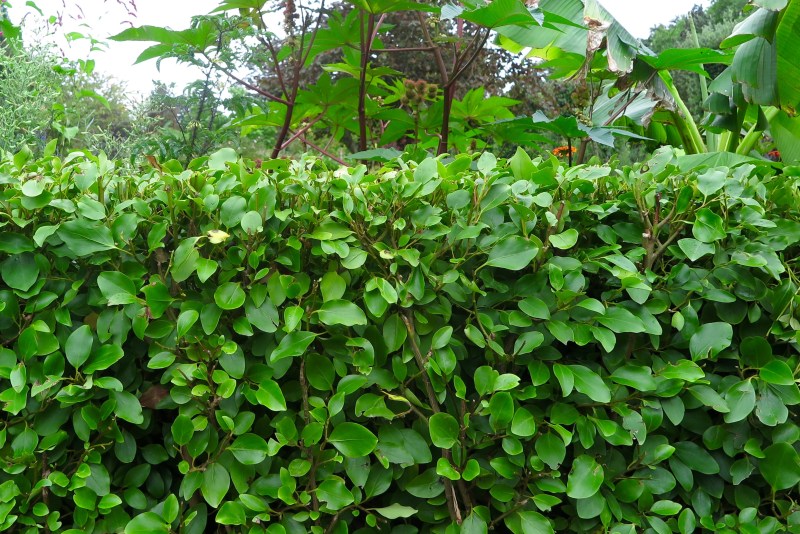
Here’s a griselinia hedge at The Salutation garden in Kent. There is lush planting on the other side of it.
Viburnum tinus.
Daniel’s third recommendation is Viburnum tinus ‘Eve Price’, which has pink buds in winter and lovely white flowers in spring.
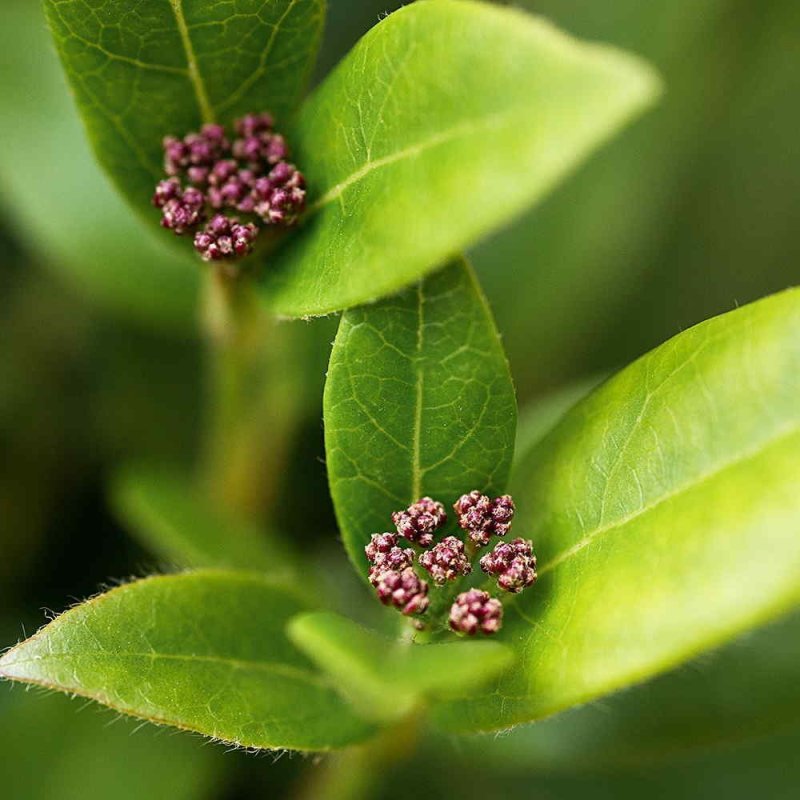
Viburnum tinus ‘Eve Price’ from Best4Hedging.
I’ve found viburnums are generally a good height for privacy or to cover an eyesore. Not all are evergreen, however.
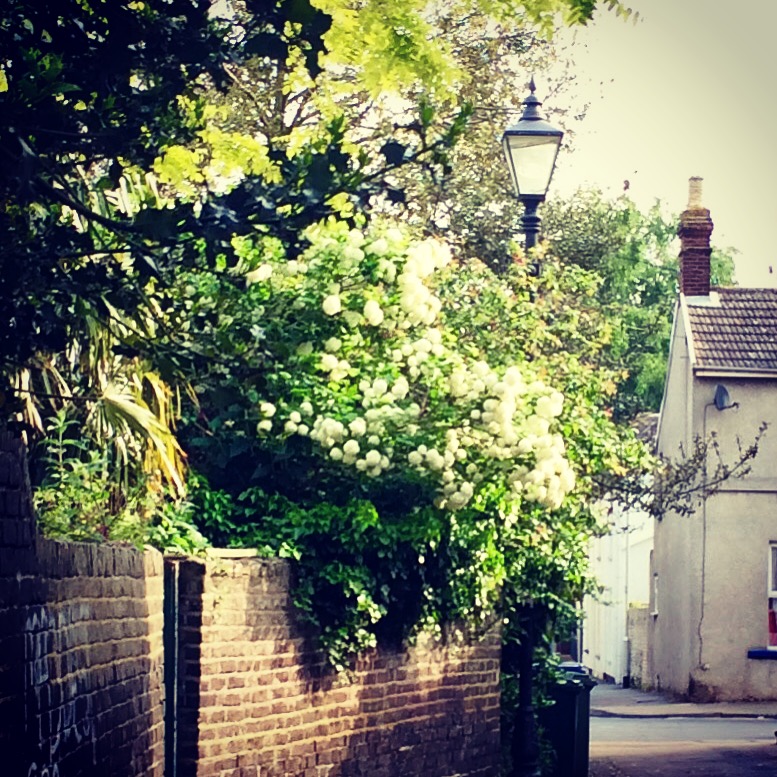
This Viburnum opulus grows over a wall in Faversham, Kent to make a garden less over-looked by its neighbours. However, it isn’t evergreen, so there’s no screening in winter.
Bamboo
Bamboo can create an excellent evergreen hedge for privacy. However, you have to be careful about your choice of bamboo. I asked Bruce Jordan of The Big Plant Nursery for his advice on using bamboo for garden privacy.

Fargesia robusta from The Big Plant Nursery.
‘Bamboo can be really good as a hedge, but some bamboos can be invasive. They need a root barrier.’ Other bamboos, however, he says, do not have invasive roots. He recommends Fargesia robusta as a bamboo type which won’t need a root barrier and is suitable for town gardens. It usually grows to between 3m-4m, depending on which variety you choose.
If you live in England, bamboo is not covered by the High Hedges Act so there’s no legal restriction on how high it can be when used as a hedge.
Hornbeam
A friend of mine used to work as a Parks Superintendent for a local council. ‘High hedges cause more trouble between neighbours than almost any other issue,’ he says. He used to get calls complaining about hedges every day.
He recommends espaliered or pleached hornbeam if you want privacy in your garden. It isn’t evergreen and is therefore exempt from the High Hedges Act. But it does hold some leaves in the winter, so it’s a good compromise.
Hornbeam also has good resistance to disease. For example, we have honey fungus in our garden, so that could be important.
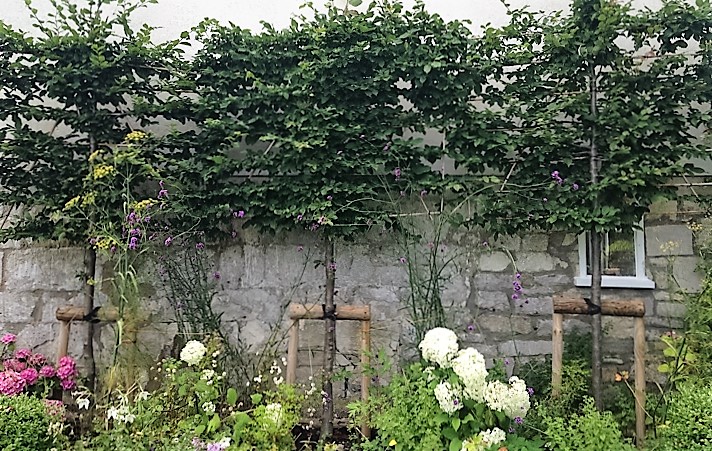
This pleached hornbeam is awaiting a trim. It makes a space-saving option for privacy.
How high can your hedges for privacy be?
This post covers the law on English hedges. However, if you live elsewhere, it will give you pointers as to what issues you may need to check before choosing your hedge. And, wherever you live, individual houses or areas may have covenants or local regulations that over-ride national laws. Check both your Deeds and your local rules.
Since the High Hedges Act 2008, a ‘high hedge’ in England is a hedge more than two metres high. That’s 6ft 5″.
A hedge, legally, is three trees or more in a row. The High Hedges Act only applies to evergreen hedges, so if the leaves of your hedge fall off in winter, then your neighbour can’t complain.
Your hedge can be higher than two metres provided it doesn’t block too much light from your neighbour’s garden or home. There are no restrictions on deciduous hedges, ivy or bamboo.
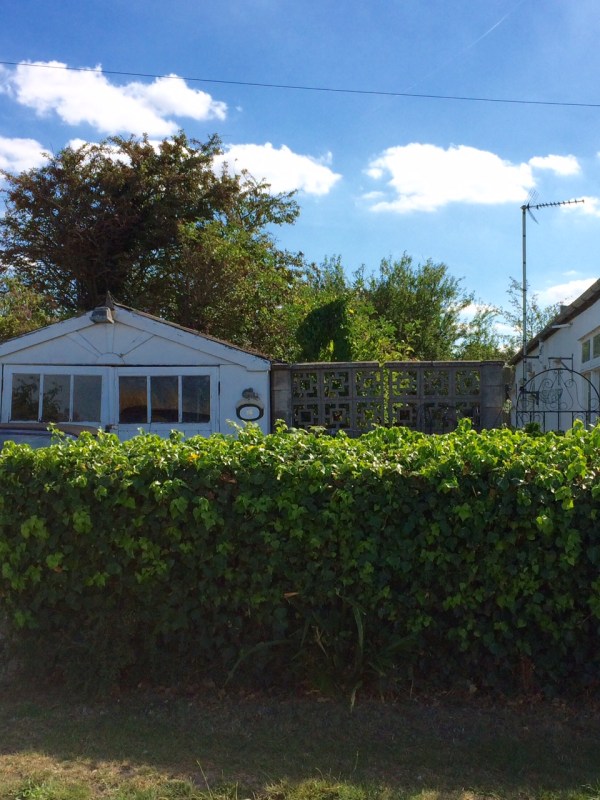
This shows that an ivy hedge can be clipped to look smart. You can grow an ivy hedge higher than this.
In 2008 The Office of the Deputy Prime Minister released a very finely-tuned calculation on how high a hedge should be. Find it here.
Even if you don’t live in England, it has useful calculations on what is fair and reasonable. It isn’t legally enforceable – it just offers guidance to councils to help them decide whether to take action against someone with a hedge higher than 6ft 5″.
Essentially, the calculation divides the square footage of your neighbour’s garden by the length of your hedge.
Then there’s an additional step to take into account which way the hedge faces. A hedge on a southern boundary affects light more than one on a northern boundary, for example. There’s also an extra calculation if the hedge affects any windows.
You could be allowed three or four metres of hedge before a council would consider it too high.
In England, you need planning permission for a fence higher than two metres in your back garden. So a hedge may be a better option because it can often be higher. Here’s a post with more about fences for privacy.
More information on garden privacy
The Middlesized Garden has a number of posts on garden privacy. You may find that a combination of elements works best for you.
You’re allowed individual trees of any height. Sometimes a single tree, carefully positioned, may be all you need to create an area of privacy in your garden. There’s more about the best perfect-for-privacy trees here.
Screening, too, can help, especially if it’s positioned near to you. There are some great new designs for garden screens now. See New directions in Garden Privacy Screens. And if you want a fence on one or more of your boundaries, here’s what you need to know about hedges for privacy.
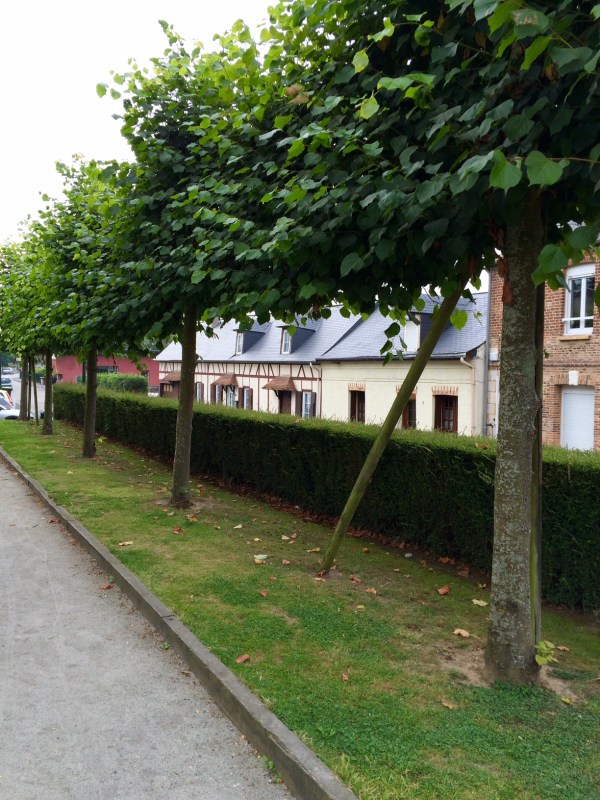
I spotted this planting in a French village. A low evergreen yew hedge is topped with a line of pleached limes, which are deciduous.
Shop my favourite gardening books, tools and products
I’m often asked for recommendations, so I’ve put together some useful lists of the gardening tools, books and products I use myself. You can find them on the Middlesized Garden Amazon store. For example, here are the main gardening tools you really need for gardening. And there’s a list of other gardening essentials, such as good gloves and kneelers.
And if you’d like a gorgeous garden, but have limited time, money or expertise, see here for a weekly email with gardening tips, ideas and inspiration.
Pin to remember hedges for privacy

























Which side do you plant a hedge on ?..or in the middle?
If it’s your hedge and you’re planting it, the roots need to be on your side of the boundary, I believe. But it’s worth checking that out with a conveyancing solicitor if you’re in any doubt.
Don’t forget about Yew being poisonous. I will never forget the panic when I discovered my young lurcher chewing on it! Stomach pumping is very expensive :(
Oh, yes, that’s terrible and good point. Most animals don’t chew it but it’s definitely something to bear in mind.
I’ve personally never understood why any domestic property needs a hedge taller than 2.5m tall. That’s plenty tall enough to provide privacy at ground level, i.e. in the garden, unless you’re living at the bottom of a steep hill. To me it seems unreasonable to impose anything taller on the neighbours just because you don’t like the view from an upstairs window or don’t want to put down the blinds before showering / getting dressed. If you hve such a desperate desire to never be seen by anyone through a window it seems to me it’s more your problem than anyone else’s and net curtains may well be a better answer.
Indeed, I agree that 2.5 metres is a good height for a domestic hedge – it’s 8ft 2″ in ‘old money”, and very much the kind of height the guidelines recommend. The problems arise when people complain about hedges or fences over 6ft – which really isn’t very private for anyone who’s taller than that. Because we live in a very crowded island, we all have to find our ideal balance between privacy and light. Being considerate of the neighbours, whichever side of the hedge you’re on, is definitely part of that.
It’s always lovely if folk can afford to be a little more patient with gardens, and in particular establishing hedges. Not only can one achieve a lot more for very little expense, but there are some wonderful options such as using fruit trees to make a hedge or screen, and in particular Quince. Yew is also much faster than myth tells us, so there’s no need to rule it out.
Thank you, Matt, very good advice from you as always. Quince is a really interesting idea – I am experimenting with espaliered apples to form a screen but hadn’t thought of the wonderful quince.
This couldln’t be more topical as a friend has just received an unpleasant letter from a neighbour about her ‘hedge’ (his definition). I shall be forwarding this to her – you main gain another follower!
Thank you! The Deputy Prime Minister’s guidelines are oddly unknown – she may have to send them to her Council. And they are guidance rather than law, but I think Parks departments get rather fed up of people fussing over the height of other people’s hedges – all they really want is for everyone to be reasonable.